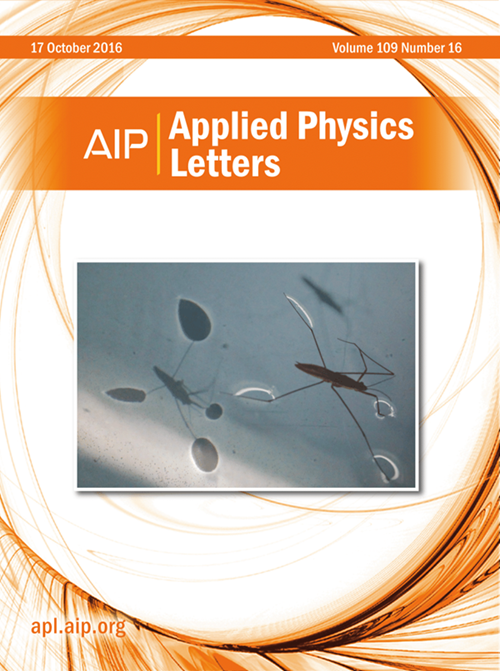新兴的超宽带隙半导体器件热计量
IF 3.5
2区 物理与天体物理
Q2 PHYSICS, APPLIED
引用次数: 0
摘要
超宽带隙(UWBG)半导体材料,如β−Ga2O3(氧化镓)、AlN(氮化铝)、AlxGa1−xN (AlGaN)和金刚石,由于其优越的电子性能,已成为大功率、高频应用中必不可少的元件候选材料。然而,除了金刚石和氮化铝外,这些材料都面临着独特的热管理挑战,主要是因为它们的导热系数低,无法满足高功率密度的需求。因此,需要采用具有新器件架构的新型热管理方法来防止UWBG器件中的峰值温度过高。同时,精确的器件级热表征(具有高空间/时间分辨率)对于验证和优化这些设计至关重要,其总体目标是提高器件性能和可靠性。本文讨论了目前用于UWBG半导体器件的热测量技术,包括:光学方法(拉曼和热反射);电学方法(栅极电阻测温);而扫描探针方法(扫描热显微镜)。更具体地说,探讨了每种热计量的稳态和瞬态能力,并强调了每种技术的局限性。最后,本展望概述了瞬态热反射成像的潜在进展,包括用于氮基异质结构的高光谱方法和用于氧化镓基电子器件的亚带隙激发技术。此外,展望了未来热反射显微镜的发展方向。该显微镜具有高透光性,在深紫外波长范围内,用于UWBG器件的近带隙热反射成像。本文章由计算机程序翻译,如有差异,请以英文原文为准。
Emerging thermal metrology for ultra-wide bandgap semiconductor devices
Ultrawide bandgap (UWBG) semiconductor materials, such as β−Ga2O3 (gallium oxide), AlN (aluminum nitride), AlxGa1−xN (AlGaN), and diamond, have emerged as essential candidates for components in high-power, high-frequency applications due to their superior electronic properties. However, with the exception of diamond and AlN, these materials present unique thermal management challenges, primarily because of their low thermal conductivities that are incapable of managing the demand for high power densities. Therefore, novel thermal management approaches that feature new device architectures are needed to prevent excessively high peak temperatures in UWBG devices. In parallel, accurate device-level thermal characterization (with high spatial/temporal resolution) is crucial to verify and optimize these designs with an overall goal to improve device performance and reliability. This paper discusses current thermal metrology techniques used for UWBG semiconductor devices covering: optical methods (Raman and thermoreflectance); electrical methods (gate resistance thermometry); and scanning probe methods (scanning thermal microscopy). More specifically, the steady-state and transient capability of each thermal metrology is explored and the limitation of each technique is highlighted. Finally, this perspective outlines potential advances in transient thermoreflectance imaging including a hyperspectral approach for nitride based heterostructures and a sub-bandgap excitation technique for gallium oxide based electronics. Additionally, the development of a future thermoreflectance microscope is presented. This microscope features high optical transmission, in the deep ultra violet wavelength range, for near bandgap thermoreflectance imaging of UWBG devices.
求助全文
通过发布文献求助,成功后即可免费获取论文全文。
去求助
来源期刊

Applied Physics Letters
物理-物理:应用
CiteScore
6.40
自引率
10.00%
发文量
1821
审稿时长
1.6 months
期刊介绍:
Applied Physics Letters (APL) features concise, up-to-date reports on significant new findings in applied physics. Emphasizing rapid dissemination of key data and new physical insights, APL offers prompt publication of new experimental and theoretical papers reporting applications of physics phenomena to all branches of science, engineering, and modern technology.
In addition to regular articles, the journal also publishes invited Fast Track, Perspectives, and in-depth Editorials which report on cutting-edge areas in applied physics.
APL Perspectives are forward-looking invited letters which highlight recent developments or discoveries. Emphasis is placed on very recent developments, potentially disruptive technologies, open questions and possible solutions. They also include a mini-roadmap detailing where the community should direct efforts in order for the phenomena to be viable for application and the challenges associated with meeting that performance threshold. Perspectives are characterized by personal viewpoints and opinions of recognized experts in the field.
Fast Track articles are invited original research articles that report results that are particularly novel and important or provide a significant advancement in an emerging field. Because of the urgency and scientific importance of the work, the peer review process is accelerated. If, during the review process, it becomes apparent that the paper does not meet the Fast Track criterion, it is returned to a normal track.
 求助内容:
求助内容: 应助结果提醒方式:
应助结果提醒方式:


